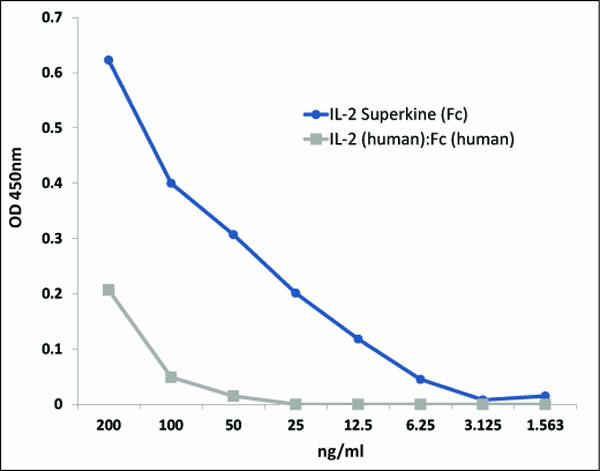IL-2 Superkine (Fc) [IL-2 (human):Fc (human) (rec.)]
| Code | Size | Price |
|---|
| AG-40B-0111-C010 | 10 ug | £235.00 |
Quantity:
| AG-40B-0111-3010 | 3 x 10 ug | £460.00 |
Quantity:
Prices exclude any Taxes / VAT
Overview
Antibody Clonality: Enzyme
Regulatory Status: RUO
Target Species: Human
Shipping:
Blue Ice
Storage:
-20°C
Images
Documents
Further Information
Alternate Names/Synonyms:
IL-2 Superkine (human):Fc (human) (rec.); Interleukin-2; T Cell Growth Factor; TCGF; Aldesleukin; Super-2
Biological Activity:
Triggers T cell proliferation at concentration <10ng/ml in the presence of 250ng/mL each of anti-CD3 (ANC-144-020) and anti-CD28 (ANC-177-020) antibodies.
Concentration:
0.1mg/ml after reconstitution.
EClass:
32160000
Endotoxin:
<0.01EU/µg protein (LAL test; Lonza).
Form (Short):
liquid
Formulation:
Lyophilized. Contains PBS.
Handling Advice:
After reconstitution, prepare aliquots and store at -20°C.Avoid freeze/thaw cycles.Centrifuge lyophilized vial before opening and reconstitution.PBS containing at least 0.1% BSA should be used for further dilutions.
Long Description:
Protein. The extracellular domain of human IL-2 (aa 21-153) (mutant H9 containing the mutations L80F / R81D / L85V / I 86V / I92F) is fused at the C-terminus to the Fc portion of human IgG2. Source: HEK 293 cells. Endotoxin content: <0.01EU/µg protein (LAL test; Lonza). Lyophilized. Contains PBS. Binds to human and mouse IL-2R. Purity: >95% (SDS-PAGE). Interleukin-2 (IL-2) is a 133 amino acid glycoprotein with one intramolecular disulfide bond and variable glycosylation. It is secreted by activated T cells and induces proliferation and maturation of activated T cells, natural killer cells and lymphokine activated killer cells. IL-2 also stimulates proliferation of antibody-producing B cells, activates neutrophils and induces mononuclear cells to secrete IFN-gamma and TNF-alpha and -beta. Moreover, studies have shown that IL-2 is required for activation-induced apoptosis, an important homeostatic mechanism in the immune system, which is involved in the maintenance of peripheral tolerance to self-antigens. IL-2 promotes T cell proliferation and particularly naive T cells. IL-2 signaling on activated T cells is effected through a quaternary high-affinity receptor complex consisting of IL-2, IL-2Ralpha (CD25), IL-2Rbeta and IL-2Rgamma. Naive T cells are relatively insensitive to IL-2 as they only express small amounts of IL-2Rbeta and IL-2Rgamma. They only acquire sensitivity after CD25 expression, which captures the cytokine and presents it to the IL-2Rbeta and IL-2Rgamma receptors. IL-2 Superkine (Fc) is an artificial variant of IL-2 containing mutations at positions L80F / R81D / L85V / I 86V / I92F. These mutations are located in the molecule's core that acts to stabilize the structure and to give it a receptor-binding conformation mimicking native IL-2 bound to CD25. These mutations effectively eliminate the functional requirement of IL-2 for CD25 expression and elicit proliferation of T cells. Compared to IL-2, the IL-2 superkine induces superior expansion of cytotoxic T cells, leading to improved antitumour responses in vivo, and elicits proportionally less toxicity by lowering the expansion of Tregulatory cells and reducing pulmonary oedema.
Molecular Weight:
42kDa
NCBI, Uniprot Number:
P60568
Package Type:
Plastic Vial
Product Description:
Interleukin-2 (IL-2) is a 133 amino acid glycoprotein with one intramolecular disulfide bond and variable glycosylation. It is secreted by activated T cells and induces proliferation and maturation of activated T cells, natural killer cells and lymphokine activated killer cells. IL-2 also stimulates proliferation of antibody-producing B cells, activates neutrophils and induces mononuclear cells to secrete IFN-gamma and TNF-alpha and -beta. Moreover, studies have shown that IL-2 is required for activation-induced apoptosis, an important homeostatic mechanism in the immune system, which is involved in the maintenance of peripheral tolerance to self-antigens. IL-2 promotes T cell proliferation and particularly naive T cells. IL-2 signaling on activated T cells is effected through a quaternary high-affinity receptor complex consisting of IL-2, IL-2Ralpha (CD25), IL-2Rbeta and IL-2Rgamma. Naive T cells are relatively insensitive to IL-2 as they only express small amounts of IL-2Rbeta and IL-2Rgamma. They only acquire sensitivity after CD25 expression, which captures the cytokine and presents it to the IL-2Rbeta and IL-2Rgamma receptors. IL-2 Superkine (Fc) is an artificial variant of IL-2 containing mutations at positions L80F / R81D / L85V / I 86V / I92F. These mutations are located in the molecule's core that acts to stabilize the structure and to give it a receptor-binding conformation mimicking native IL-2 bound to CD25. These mutations effectively eliminate the functional requirement of IL-2 for CD25 expression and elicit proliferation of T cells. Compared to IL-2, the IL-2 superkine induces superior expansion of cytotoxic T cells, leading to improved antitumour responses in vivo, and elicits proportionally less toxicity by lowering the expansion of Tregulatory cells and reducing pulmonary oedema.
Purity:
>95% (SDS-PAGE)
Sequence:
The extracellular domain of human IL-2 (aa 21-153) (mutant H9 containing the mutations L80F / R81D / L85V / I 86V / I92F) is fused at the C-terminus to the Fc portion of human IgG2.
Source / Host:
HEK 293 cells
Specificity:
Binds to human and mouse IL-2R.
TAGs:
Fc
Transportation:
Non-hazardous
UNSPSC Category:
Interleukins
UNSPSC Number:
41116127
Use & Stability:
Stable for at least 6 months after receipt when stored at -20°C. Working aliquots are stable for up to 3 months when stored at -20°C.
References
Exploiting a natural conformational switch to engineer an interleukin-2 'superkine': AM. Levin, et al.; Nature 484, 529 (2012)
Related Products
| Product Name | Product Code | Supplier | anti-IL-2 (human), mAb (ANC7F7) | ANC-245-020 | Ancell | Summary Details | |||||||||||||||||||||||||||||||||||||||||||||||||||||||||||||||||||||||||||||||||||||||||||||
|---|---|---|---|---|---|---|---|---|---|---|---|---|---|---|---|---|---|---|---|---|---|---|---|---|---|---|---|---|---|---|---|---|---|---|---|---|---|---|---|---|---|---|---|---|---|---|---|---|---|---|---|---|---|---|---|---|---|---|---|---|---|---|---|---|---|---|---|---|---|---|---|---|---|---|---|---|---|---|---|---|---|---|---|---|---|---|---|---|---|---|---|---|---|---|---|---|---|---|---|



